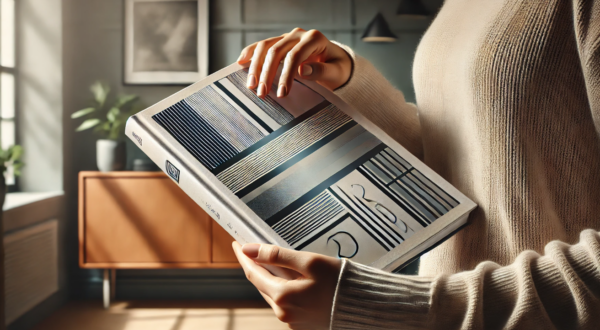In the highly competitive world of book publishing, the importance of a well-crafted cover is paramount. Serving as more than mere decoration, the cover is the crucial link connecting the book to potential readers, effectively capturing the essence, tone, and genre of the work. By harmoniously blending marketing, artistic creativity, and a deep understanding of the book’s theme and intended audience, a cover can distinguish itself amidst a multitude of titles, drawing readers into the narrative journey it promises.
This article aims to explore the intricacies of book cover design, highlighting its significance in capturing potential readers’ attention and conveying a book’s essence. It delves into the strategic blend of marketing, art, and content comprehension necessary to create book covers that resonate with the intended audience, thereby enhancing a book’s marketability and appeal. Continue reading to find out the best book cover design tips!
Fundamentals of Book Cover Design
This guide delves into essential elements that combine to capture the essence of a book, ensuring it stands out and speaks directly to its intended audience. Here are the key elements and considerations in the process of professional book cover design:
Elements of Design:
- Color: The color palette sets the mood and tone of the book. Bright colors might be used for light-hearted books, while darker tones would suit more serious or suspenseful themes. Color choices can also influence cultural and emotional responses, making it essential to consider the target audience’s perceptions.
- Typography: The style, size, and placement of text on the cover are critical. The font should match the book’s genre and tone. For instance, a fantasy novel might use ornate fonts, while a modern thriller might opt for bold, clean typography.
- Imagery: Images, whether photographs or illustrations are potent storytelling tools. They should be relevant to the book’s content and genre, and able to catch the eye and intrigue potential readers.
Balancing Visual Elements and White Space
Mastering the balance between visual elements and white space is crucial in book cover design. Too much clutter can overwhelm, obscuring the book’s theme, while excessive simplicity might render it invisible in a crowded market. Harmonizing the title, author’s name and imagery is key, ensuring no element overshadows another. White space, or negative space, is more than mere emptiness; it’s a strategic tool that highlights core elements, lending the cover a clean, professional look. This not only captures attention but also retains it, inviting readers to delve into the book’s depths.
The Role of Front Cover, Back Cover, and Spine:
- The Front Cover is the main attraction, it should instantly convey the book’s genre and tone. It should be eye-catching and inviting. Incorporating a couple of short, positive reviews can effectively capture the interest of prospective readers.
- The Back Cover usually includes a blurb, author bio, or reviews. This space should continue the aesthetic of the front cover but in a more subdued manner, allowing the text to be easily readable.
- The Spine, while often overlooked, is a crucial element, especially for physical books in stores. It needs to stand out when shelved and include the title and author’s name clearly.
Understanding Your Book and Target Audience
Designing a book cover is a strategic process that starts with thoroughly understanding the book’s genre and target audience. This step is vital as it shapes every aspect of the design, ensuring it appeals directly to those most likely to be interested in the book. Each genre has a distinct visual language that should always be considered. The book cover design should not only instantly signal the genre to browsers but also encapsulate the book’s theme and tone.
Aligning with genre-specific reader expectations is crucial to avoid misleading potential readers. The cover needs to accurately represent the book’s content, ensuring it resonates with the intended audience and fulfills their expectations. Ultimately, a successful cover design merges genre-specific visual cues, thematic elements, and audience insight to create an engaging and authentic invitation to readers.
Professional Book Cover Designer
Hiring a professional book cover designer can be a game-changer in the journey of publishing a book. Below we highlight the benefits of hiring a professional and how to work with them.
Benefits of Hiring a Book Cover Designer:
- Expertise and Experience: Professional designers bring a wealth of knowledge about visual elements, genre-specific trends, and what works in the print book market. Their experience ensures that the cover is not only visually appealing but also effective in attracting the target audience.
- Technical Skills: Designers are adept at using advanced design software, which means they can create high-quality, print-ready covers that meet industry standards.
- Time Efficiency: With a designer handling the cover, authors can focus on other aspects of writing and marketing their book.
How to Communicate Your Vision:
Before contacting a graphic designer, it’s essential to clearly understand your book’s content and audience, providing a solid foundation for the cover design to accurately mirror your work’s essence. Including visual examples that align with your book’s theme or personal aesthetic preferences can significantly enhance the collaborative process. These references visually articulate your vision, ensuring more effective communication than words alone, and guide the graphic designer towards a design that meets your expectations.
Openness to the designer’s expertise is equally important; their experience and fresh perspective can introduce innovative ideas that enhance your cover beyond initial concepts. This collaborative exchange not only enriches the design process but also ensures the final cover not only meets but possibly exceeds your expectations, captivating your target audience with its unique appeal and accurately reflecting the narrative within.
SIMPLE STEPS TO FINDING YOUR GRAPHIC DESIGNER
1. Review Portfolios: Start by examining the designer’s past work to ensure their style matches your vision.
2. Check Reviews: Look at feedback from previous clients to gauge the designer’s reliability and professionalism.
3. Discuss Terms: Have a clear conversation about fees and timelines to avoid any future misunderstandings.
4. Evaluate Communication: Ensure the design team and the designer is open, responsive, and collaborative for a smooth design process.
DIY: Designing Your Own Book Cover
In the age of digital tools and resources, designing your own book cover has become a feasible option for many authors, especially those who are self-publishing. It offers creative control and personalization, allowing you to directly translate your vision onto the cover. It’s a cost-effective approach that can be rewarding, providing a deep sense of accomplishment and a unique connection between the book’s content and its visual representation.
Benefits of DIY:
- Creative Control: Directly influence the cover’s look, ensuring it aligns with your vision.
- Cost-Effectiveness: A DIY approach can be more affordable, avoiding professional design fees.
- Personal Satisfaction: There’s a unique sense of fulfillment in creating your book’s visual identity.
DIY Book Cover Design Tools and Software:
Creating your own book cover is accessible thanks to a myriad of tools, software, and online resources:
Canva and Adobe Spark: These would be good options to use for beginners as they offer user-friendly interfaces and a plethora of templates, ideal for those new to design. They allow easy experimentation with layouts, fonts, and colors.
Adobe Photoshop and InDesign: Provide more sophisticated customization and professional-grade features, suited for those with more design experience or a desire to learn.
Utilizing Templates and Online Resources:
Leverage the wealth of online platforms for an easier design process:
Book Cover Templates: Many sites provide professional templates for book designers, that can be tailored to your book, simplifying the design process.
Design Resources: Utilize stock photo sites, font libraries, and color palette generators for the necessary design elements.
Using the right tools and design principles to create a captivating cover can be key to making your book a bestseller. A professional and alluring cover captures the essence of your story, drawing in the reader’s eye and your target audience. This not only enhances the book’s marketability but also maximizes its appeal, increasing the likelihood of it standing out in a competitive market, all achieved through an efficient and cost-effective DIY approach.
Using AI in Book Cover Design
The advent of Artificial Intelligence (AI) in creative fields has opened new frontiers in book cover design.
Benefits of Using AI:
- Efficiency: AI streamlines cover design, swiftly producing diverse concepts, enabling faster decision-making and a more dynamic creative process.
- Cost-Effectiveness: Reduces the need for expensive professional designers, without significantly compromising on quality.
- Innovation: Offers creative designs that might not be immediately obvious to humans.
- Customization: AI customizes covers by analyzing data, ensuring designs align perfectly with genre or theme nuances for targeted audience appeal.
- Consistency: Maintains a uniform style across a series of book covers.
AI Assistance in Cover Design:
AI tools are capable of analyzing and processing large datasets, which include a vast array of existing book covers. By understanding trends, color schemes, and typography popular in certain genres, AI can generate design suggestions that are in line with market preferences. These tools can also quickly produce multiple variations of a few book cover ideas, providing a range of options to choose from or refine further.
Available AI Tools:
Automated Layout Generators: Tools that use AI to propose cover layouts, arranging elements like images, titles, and author names optimally based on design principles.
Style Transfer: AI algorithms that can apply the artistic style of one image to another, allowing designers to create unique covers by blending different visual styles.
Image Enhancement: AI-driven software can enhance low-resolution images to high-quality ones suitable for covers without losing detail.
Font and Color Scheme Suggestions: AI can analyze a book’s content and suggest fonts and color schemes that match the mood or theme of the book.
Content-Aware Design Tools: These tools use AI to understand the content of a book and generate cover art concepts that are contextually relevant to the book’s narrative.
AI-powered publishing platforms such as Spines harness these advanced tools to craft best-selling cover designs, guiding authors through a seamless design process to achieve the ideal cover for their books. At Spines, the focus isn’t limited to just the front cover; they ensure a holistic approach by designing the back and spine as well, ensuring a unified and cohesive look across the entire cover. To experience Spines’ innovative design solutions, you can sign up for free and embark on your book cover creation journey.
The Impact of Digital and Print Formats
The book industry’s evolution into digital realms necessitates a dual focus on cover design, catering to both traditional print and hardcover book formats and the increasingly popular e-books. This shift requires authors and designers to consider how a cover design translates across different mediums, each with its unique set of characteristics and constraints.
Differences in Designing for eBooks and Physical Books:
eBooks (e-reader screens): Designing for digital formats means considering how the cover will look on a variety of screens, from e-readers to tablets and smartphones. Brightness and color variations across devices mean that colors might not always display as intended. Moreover, since e-books are often browsed in online stores where covers are shown as small thumbnails, the design must be legible and captivating even at a reduced size. This often requires a focus on bold typography and a clear, simple visual element.
Physical Books (Hardcover, Paperback): Physical book covers have more tactile elements, like texture and embossing, which can add to the reader’s experience. The book design also extends beyond the front cover to include the spine and back cover, which are integral parts of the overall design. The spine, in physical paperback in particular, must be legible and eye-catching as it is often the first thing seen when a book is on a shelf.
Your Publishing Journey Awaits – Start NowIncorporating Graphic Elements and Typography
A book cover’s visual impact hinges significantly on the judicious selection of graphic elements and the strategic use of typography. These components are not mere embellishments; they are vital storytelling tools that can attract and communicate with potential readers.
Choosing Images and Graphics:
- Conveying the Right Message: The imagery on a book cover should be a visual metaphor for the book’s content. It should align with the book’s theme and genre, giving potential readers a hint of the journey they’re about to embark on.
- Emotional Resonance: The chosen image should evoke an emotional response that aligns with the book’s tone. Bright and vibrant images can create a sense of joy and excitement, while darker tones might evoke mystery or seriousness.
- Relevance and Originality: The graphics must be not only relevant but also offer a fresh perspective. This helps the book to stand out in a crowded market.
Typography Tips for the Book’s Title and Author Name:
- Legibility and Size: The title should be easily readable, even when the cover is viewed as a small thumbnail in digital stores. This often means bold, clear fonts.
- Font Style: The choice of font should reflect the book’s genre. For instance, a script font may suit romance novels, while sans-serif fonts are a popular choice for non-fiction.
- Hierarchy: The title should usually be the most prominent text element, followed by the author’s name. Any additional text, like taglines or endorsements, should not overshadow these key elements.
Incorporating graphic elements and typography effectively on a book cover is a complex yet rewarding task. It requires a deep understanding of the book’s core message and audience, coupled with a keen eye for visual storytelling. Done right, it can transform a simple cover into a compelling invitation to delve into the pages within.
Genre-Specific Cover Design Tips
Designing a book cover that resonates with its intended audience requires a keen understanding of genre-specific aesthetics and expectations. Each literary genre has its unique visual language and conventions that can guide the design process, while also providing opportunities for creativity and differentiation.
Adapting Design Strategies for Different Genres:
- Romance: Often features imagery depicting love and intimacy, with warm, inviting color palettes. Script fonts that suggest elegance and passion are commonly used.
- Thriller/Mystery: Darker color schemes and shadowy images are typical, evoking suspense and intrigue. Bold, stark typography can add to the sense of urgency.
- Science Fiction/Fantasy: These covers might include elements of futuristic landscapes, fantastical creatures, or otherworldly imagery. The typography often mirrors the futuristic or mystical elements of the content.
- Non-fiction/Self-help: Typically adopts a cleaner, more minimalist approach. The focus is often on bold, straightforward typography and symbolic imagery that conveys the book’s central theme or idea.
Avoiding Clichés and Standing Out in Popular Categories
While it’s important to adhere to genre conventions to meet reader expectations, there’s a fine line between convention and cliché. To stand out, it’s crucial to bring a fresh perspective or unique twist to familiar themes. For instance, in a fantasy novel, rather than using the typical dragons or wizards, you might opt for a less common mythological element or an unexpected color scheme.
Experimenting with typography, such as using a modern, unexpected font in a historical fiction cover, can also create distinction. Incorporating elements that hint at the unique aspects of the story or author’s style can help the book stand out. This could be a unique setting, a distinctive character trait, or an unusual plot element, visually represented.
Finalizing the Design: Feedback and Revision
The journey of creating a book cover doesn’t end with the initial design. Finalizing the cover often involves a cycle of feedback, iteration, and revision, ensuring that the end product resonates with potential readers and meets industry standards.
Importance of Feedback:
From Potential Readers: Gaining insights from your own target reader audience can be invaluable. They can provide honest reactions and tell you whether the cover effectively communicates the book’s genre and content. This feedback is crucial because it comes from those who are most likely to purchase and read the book.
From Industry Professionals: Feedback from publishing professionals, such as editors, marketing experts, or even other authors, can provide a different perspective. They can offer advice on market trends, genre expectations, and technical aspects of the cover design.
Iterating and Refining the Cover Design
Iteration is a natural and necessary part of the design process. Based on the feedback received, adjustments may need to be made. This could involve tweaking color schemes, changing fonts, or altering images. The goal is to refine the cover art so that it not only looks appealing but also aligns accurately with the book’s content and appeals to the intended audience. This process might take several rounds, and it’s important to be open to change and improvement.
Knowing When to Go Back to the Drawing Board
There are times when minor tweaks are not enough, and a more significant overhaul is required. Recognizing this need is crucial. It could be due to a mismatch between the cover and the book’s tone, a lack of clarity in conveying the genre, or simply because the design isn’t engaging enough. This doesn’t signify failure but rather an opportunity to realign the cover with the book’s core essence. Going back to the drawing board can be a bold but necessary step to ensure the cover is effective in its role as a marketing tool and an invitation to readers.
Finalizing a book cover is a balancing act of respecting initial design intentions while being receptive to constructive feedback and willing to make necessary changes. This process ensures that the final cover is not just aesthetically pleasing but also strategically aligned with the book’s marketing and branding goals.
Marketing Considerations and the Book Cover
In the competitive world of book publishing, a cover is more than just a protective wrapping for the pages within; it’s a critical marketing tool, both in physical bookstores and on online platforms. The design of a book cover can significantly influence a book’s marketability and its ability to attract the right readers, ultimately impacting sales.
The Cover as a Marketing Tool:
In Bookstores: In a physical bookstore, a book’s cover is the first thing that catches a potential reader’s eye. It needs to stand out on the shelves, compelling a customer to pick it up for a closer look. The cover must be visually appealing and clearly convey the genre and tone of the book, enticing the right audience.
On Online Platforms: The dynamics change slightly in digital spaces. Here, the cover needs to be impactful even when displayed as a small thumbnail. This requires a focus on clear, legible typography and a simple yet striking image that can be understood at a glance.
Ensuring the Cover Works Well as a Tiny Thumbnail:
With the majority of book browsing now happening online, the book cover must be designed to retain its appeal and readability in a much-reduced size. This means prioritizing clarity and simplicity in design elements, ensuring that the cover remains effective and engaging even in thumbnail form.
Attracting the Right Readers and Boosting Sales:
A compelling cover grabs attention and communicates the book’s essence at first sight. It acts as a visual summary of what the reader can expect, thus attracting the right audience. A great cover that resonates with its intended readers is more likely to lead to purchases, making it a powerful tool in the book’s overall marketing strategy.
In essence, the book cover serves as a silent salesman, working tirelessly in various settings to both sell books and attract potential readers. Its role in the marketing and commercial success of a book cannot be understated, making its design a pivotal aspect of the publishing process.
Creating a bestseller cover is a fusion of art, marketing, visual inspiration, and strategic design. It requires understanding your audience, balancing visual elements, and adapting to various formats. Authors should invest time and thoughtful consideration into their covers, as they are essential in capturing reader’s attention, conveying story themes, and ultimately driving book sales.
Your Publishing Journey Awaits – Start Now






